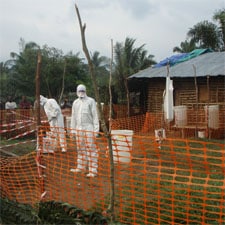Ebola Hemorrhagic Fever
Prevention
The prevention of Ebola HF presents many challenges. Because it is still unknown how exactly people are infected with Ebola HF, there are few established primary prevention measures.When cases of the disease do appear, there is increased risk of transmission within health care settings. Therefore, health care workers must be able to recognize a case of Ebola HF and be ready to employ practical viral hemorrhagic fever isolation precautions or barrier nursing techniques. They should also have the capability to request diagnostic tests or prepare samples for shipping and testing elsewhere.

MSF (Médecins Sans Frontières) health staff in protective clothing constructing perimeter for isolation ward.
- wearing of protective clothing (such as masks, gloves, gowns, and goggles)
- the use of infection-control measures (such as complete equipment sterilization and routine use of disinfectant)
- isolation of Ebola HF patients from contact with unprotected persons.
CDC, in conjunction with the World Health Organization, has developed a set of guidelines to help prevent and control the spread of Ebola HF. Entitled Infection Control for Viral Hemorrhagic Fevers In the African Health Care Setting, the manual describes how to:
- recognize cases of viral hemorrhagic fever (such as Ebola HF)
- prevent further transmission in health care setting by using locally available materials and minimal financial resources.